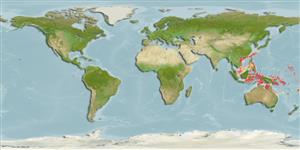Teleostei (teleosts) >
Gobiiformes (Gobies) >
Gobiidae (Gobies) > Gobiinae
Etymology: Tryssogobius: Greek, tryo, tryso = to wear away + see under Gobius; nigrolineatus: Name from Latin 'nigro' for black and 'lineatus' for line, refers to the longitudinal black line on the postorbital head and the side of the body.
More on author: Randall.
Environment: milieu / climate zone / depth range / distribution range
Ecology
Marine; demersal; depth range 73 - 110 m (Ref. 75950). Tropical
Western Pacific: Ryukyu Is., Fiji and Indonesia.
Size / Weight / Age
Maturity: Lm ? range ? - ? cm
Max length : 2.9 cm SL male/unsexed; (Ref. 75950)
Short description
Identification keys | Morphology | Morphometrics
Dorsal spines (total): 7; Dorsal soft rays (total): 10; Anal spines: 1; Anal soft rays: 11; Vertebrae: 26. This species is characterized by the following: D VI + I, 10; A I, 11; pectoral rays 18-20; diameter of eye 2.4-2.7 in HL; narrow interorbital width, 6.7-8.15 in HL; first 3 dorsal spines subequal, the longest 2.4-3.65 in SL; caudal fin rhomboid, 2.6-3.5 in SL; pectoral fins 3.4-3.6 in SL; colour light grey with a midlateral blackish line from behind eye to posterior caudal peduncle; blackish first dorsal spine, a yellow line at base of fin; second dorsal and caudal fins with 2 rows of yellow spots, anal fin with 1 row; yellow line in middle of caudal fin (Ref. 75950).
Inhabits sand and rubble bottoms of outer reef slopes in 50-110 m (Ref. 90102). All specimens were collected by handnets from at depths of 73-110 m off Viti Levu, while diving with mixed-gas rebreather gear (Ref. 75950).
Life cycle and mating behavior
Maturity | Reproduction | Spawning | Eggs | Fecundity | Larvae
Randall, J.E., 2006. Three new species of the gobiid fish genus Tryssogobius from the western and South Pacific. Aqua, 11(3):105-116. (Ref. 75950)
IUCN Red List Status (Ref. 130435: Version 2024-2)
Threat to humans
Harmless
Human uses
Tools
Special reports
Download XML
Internet sources
Estimates based on models
Preferred temperature (Ref.
123201): 20.2 - 27.1, mean 25.9 °C (based on 40 cells).
Phylogenetic diversity index (Ref.
82804): PD
50 = 0.5078 [Uniqueness, from 0.5 = low to 2.0 = high].
Bayesian length-weight: a=0.01023 (0.00477 - 0.02194), b=3.01 (2.83 - 3.19), in cm total length, based on LWR estimates for this (Sub)family-body shape (Ref.
93245).
Trophic level (Ref.
69278): 3.1 ±0.3 se; based on size and trophs of closest relatives
Resilience (Ref.
120179): High, minimum population doubling time less than 15 months (Preliminary K or Fecundity.).
Fishing Vulnerability (Ref.
59153): Low vulnerability (10 of 100).
